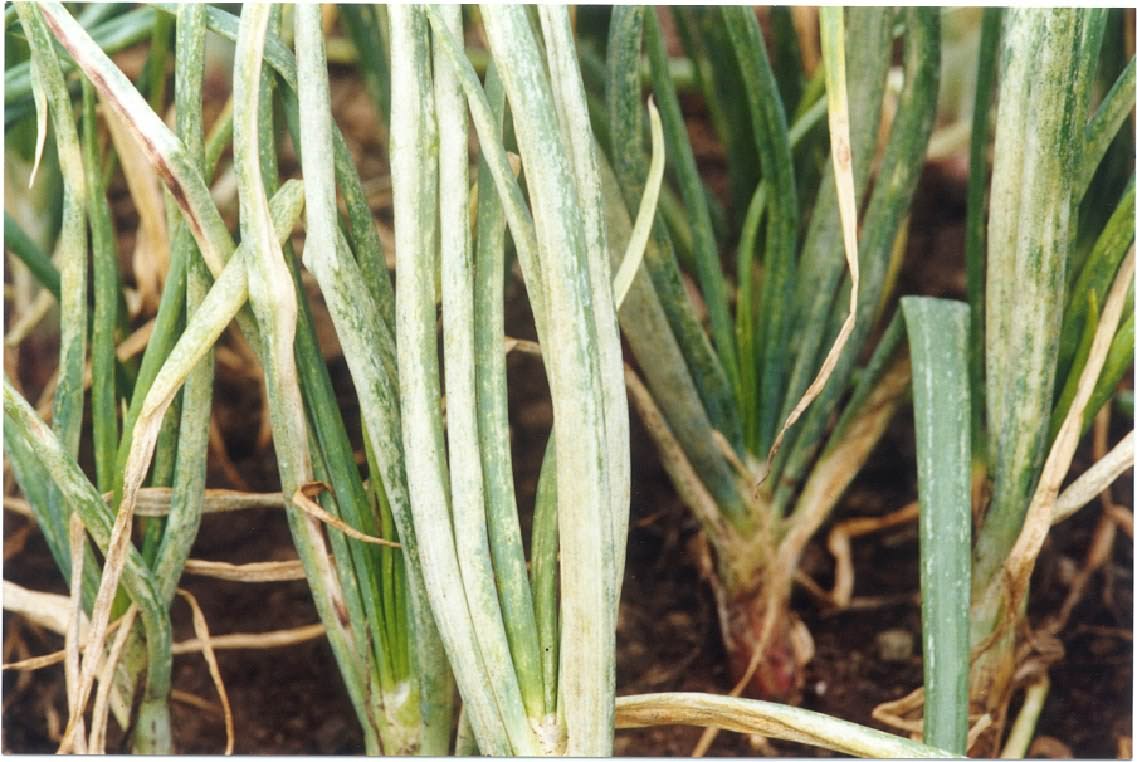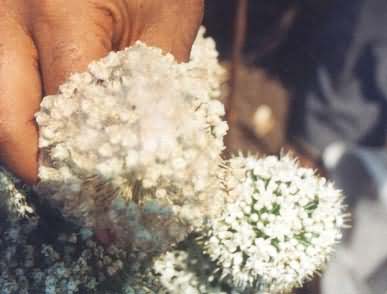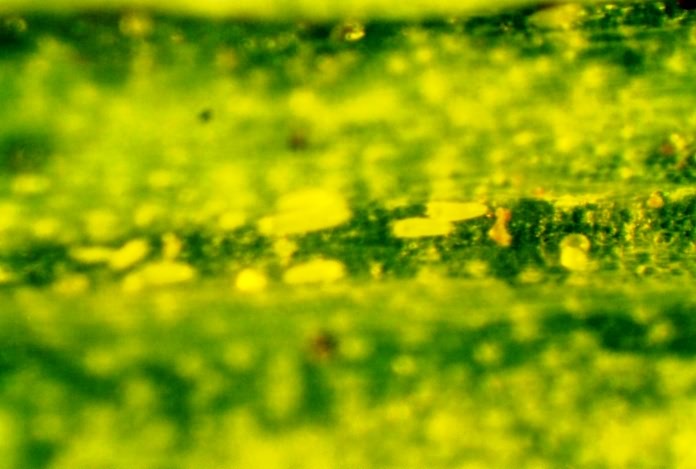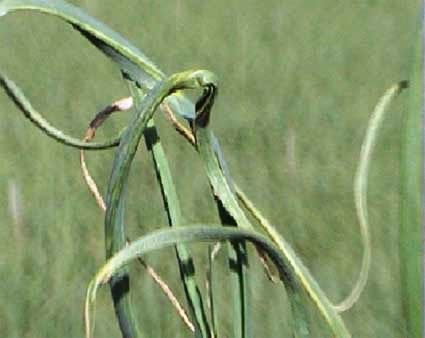प्याज और लहसुन केे कीट-पतंग और उनका प्रबंधन
Onion is a most important culinary commodity grown in India. Full yield potential of the crop is not realized due to number of constraints. Among them pest and diseases are the major constraints in onion production. Pest management is crucial for obtaining good quality marketable bulb. Major insect pests of onion, garlic with their symptoms and management practices are given below:
1. Onion thrips, Thrips tabaci Lindeman (Thysanoptera: Thripidae)
Onion thrips is a key insect pest in most onion and garlic production regions of the world. They are cosmopolitan in nature and can feed on broad host range. Some of the important alternate hosts are cabbage, cauliflower, cotton, melons and many flowering plants.
Both Immature and adult thrips feed by piercing surface tissues and suck the exuded plant juices. They cause direct damage to leaves and bulbs and also act as vector for viral diseases.
Identification
- Eggs - Initially white and later change into orange colour, kidney-bean shaped and microscopic (0.2mm) in size
- Nymphs - White to pale yellow in colour, elongate, slender body, looks like adults but lacks wings, first two instars are very active (feeding stages), while 3rd and 4th instars are inactive (non-feeding stages) called pre-pupa and pupa
- Pupa – Pale yellow to brown colour, more stout than younger instars
- Adults - Yellowish brown, Slender (1 mm), males are wingless and females have long narrow fringed wings and female insert eggs individually into leaves
Biology
- Lifecycle of thrips varies from 10-30 days depending on temperature
- Egg incubation period : 4-5 days, larval duration : 5-7 days, pupal period : 3-10 days and adults - 5-8 days
Fig 1.1. Onion thrips, Thrips tabaci Fig 1.2. Thrips on neck region plant
Damage symptom
Both nymphs and adults lacerate the onion leaf tissue and suck the sap from the leaves cause the silvery leaf spots that turn into white blotches and silvery patches along the leaves. Damaged tissues coalesces exhibiting blast like appearance. Affected tissue will dry up when the damage is severe. Damaged leaves may become papery and distorted. Infested terminals lose their colour, roll, gradually dry from tip downwards and drop leaves prematurely. Leaf tip discoloration and drying is the main symptom.

Fig 1.3. Damaged on leaves with silvery patches
Management
- Field sanitation, removal of weed and avoid successive planting of onion and garlic or mono cropping; crop rotation with non hosts will helps to reduce the population buildup
- Planting of 2 rows of maize or inner row wheat + outer row maize as barrier will blocks adult thrips movement up to 80%. It also helps to brings down insecticide sprays
- Seedlings roots dip in 0.1% Carbendazim + 0.025% Carbosulfan solution for two hours to reduce the incidence of fungal diseases and thrips damage till 30-40 days in the main field
- Monitoring of adult thrips population levels for timely management strategy using sticky traps. The yellow and bright blue traps are recommended for thrips monitoring
- Need based foliar application of insecticide sprays from 30 days after planting at 10-15 days interval. Commonly used insecticides are Carbosulfan @2ml, Profenophos @1ml, methomyl @ 1g/l (+NEEM). High volume spray fluid @ 900-1000l/ha is needed (20 pump /acre). Avoid using same insecticide repeatedly. Always add sticker @ 0.5 to 1% (0.5-1ml/l) to spray fluid.
2. Red spider mite, Tetranychus cinnabarinus (Boisduval)
This is an important and emerging pest of onion and garlic in the Indian subcontinent.
Identification
- Eggs - laid singly on the underside of the leaf or attached to the silken webs spun by the adults
- Larvae - pinkish, slightly larger than the egg and have three pairs of legs
- Nymphs - reddish or greenish and having 4 pairs of legs
- Adult - females are reddish and more or less elliptical in shape
Fig 2.1. Red spider mite Fig 2.2. Silk webbing on the leaves Fig 2.3. Silk webbing on the flowers
Damage symptoms
Adults and nymphs feed primarily on the undersides of the leaves. The upper surface of the leaves becomes stippled with little dots that are the feeding punctures. The mites tend to feed in “pockets” often near the midrib and veins. Silk webbing produced by these mites is usually visible. The leaves eventually become bleached and discolored and may fall off.
Management
- Avoid planting successive onion or garlic crops
- Apply wettable Sulfur 0.3% + dimethoate (0.03%) or 0.5% sulfur or dicofol 2ml/l (0.05%) or fenaziquin 2ml/l(Magister) as pre- sowing and post- sowing treatments
- Through water spray also washes off the mites from the plant
3. Eriophyid mite, Aceria tulipae Keifer
tulipae also called as wheat curl mite. Attacks garlic in both field and storage condition
Identification of adults
- Eriophyid mites are translucent, cigar-shaped and microscopic. Nearly invisible to the unaided eye (1/100” in length), cylindrical/cigar-shaped, tapering from head to rear, and translucent white (Fig. 3.1).
- Unlike most mites, eriophyid only have 4 legs located near the head
- Adult mite is about 200 to 250 μm length and width 36 to 52 μm. The eggs are attached to fine silk webbing and hatch in approximately
Fig 3.1. Eriophyid mite, Aceria tulipa Fig 3.2. Twisted garlic leave due to A. tulipae damage
Damage symptoms
Both adults and immature feed on the young leaves and infested leaves do not open completely. Mite feeding causes stunting, twisting, curling and discoloration of foliage. Whole plants will show curling symptom and yellow mottling is seen mostly on the edge of the leaves. This damage has been attributed to various viruses thought to be transmitted by the mites. In storage bulbs dry and desiccate.
Management
- Avoid planting successive onion or garlic crops
- Apply wettable Sulfur 0.3% + dimethoate (0.03%) or 0.5% sulfur or dicofol 2ml/l (0.05%) or fenaziquin 2ml/l(Magister) as pre- sowing and post- sowing treatments
4. Head Borer, Helicoverpa armigera Hubner (Noctuidae: Lepidoptera)
This is sporadic pest and attack onion grown for seed purpose
Identification
- Eggs - creamy white in colour, spherical, laid singly
- Larva - colour varies from greenish to brown. Green with dark brown grey lines laterally on the body with lateral white lines and also has dark and pale bands. Pupa is brown in colour, occurs in soil, within stalk and crop debris.
- Adult is light pale brownish yellow stout moth. Fore wing grey to pale brown with V shaped speck. Hind wings are pale smoky white with a broad blackish outer margin.
Damage symptom
Larvae feed inside the stem and move upwards to reach the base of the umbel at early stages of flowering. Subsequently, it invades the umbel and feeds on seeds. As a result, complete drying of flowers and complete loss of seed occurs. The larva of this insect cuts the pedicel of the flower and feeds on the stalk. Single larva damages many flower stalks. The fully-grown larva is greenish with dark brown grey lines along the side of body and measures about 35-45 mm in length.
Fig 4.1. Larva of H. armigera inside of onion stalk Fig 4.2. Dried onion umbel due to boring
Management
Onion variety Arka Niketan found to least attractive to head borer. Insecticides applied against onion thrips also effective against head borer. Use of pheromones for mass trapping and application of HaNPV, Btk formulatons would be effectively control the larvae in seed crop.
5. Cutworms, Spodoptera litura Fabricius (Noctuidae: Lepidoptera)
Identification
Adults are brown in colour. Forewings are brown colour with wavy white markings, hind wings are white colour with a brown patch along the margin. Eggs are golden yellow, laid in masses and covered by silky hairs. Larva are seen in groups, young caterpillars are light green with black head or black spots
Damage symptom
The larvae of this insect are seen in nursery beds and newly transplanted onion fields. The tender plants are found damped at ground level during the night young larvae feed gregariously on foliage but later segregate and enter into soil. Young larvae are yellowish grey and later on become brown, greasy to touch and coil when disturbed. They cut the seedlings at ground level during night and hide during day.
Management
Use pheromones traps for monitoring and mating disruption. Traps can be placed at 125cm height and dispenser should be regularly replaced. Insecticides like methomyl, Acephate@ 1.5 g/l Sl NPV will effectively control the larvae.
References
Srinivas, P.S. R.P. Singh and K.E. Lawande. 2007. Integrated Pest and Disease Management in Onion and Garlic. Technical Bulletin No.17. ICAR-Directorate of Onion and Garlic Researxch, Pune, Maharashtra, pp.34.
Srinivas, P.S. and Lawande. 2006. Maize barriers as a cultural method for manipulation of thrips in onion. The Indian Journal of Agricultural Sciences, 76(3):167-71.
Sankar, V., Thangasamy, A and Jai Gopal. 2014. Improved cultivation practices for onion. Tehnical Bulletin No. 21. ICAR-Directorate of Onion and Garlic Researxch, Pune, Maharashtra.pp.23.
Authors:
Karuppaiah, P.S. Soumia*, G. Guru Pirasanna Pandi and Suresh M Nebapure
Scientists, Indian Council of Agricultural Research, New Delhi-110012
Corresponding author Email:
Email:









